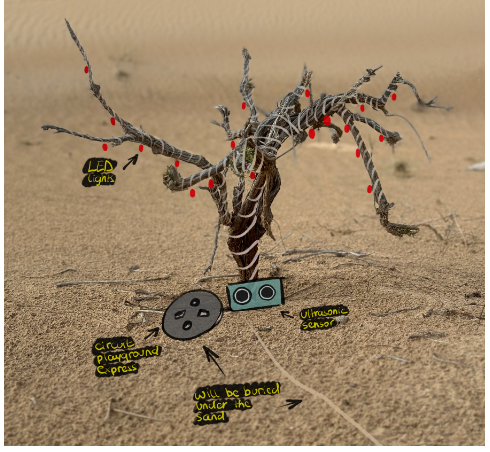Adina Maratkyzy, Aiya Sartbayeva, Maimuna Zaheer, Rhea Braithwaite
Overview
Desert Whispers, is a toolkit designed to ethically augment existing desert plants and give these living beings a voice. Within the toolkit are led lights, a speaker as well as a distance sensor. The speaker, using sound, encourages visitors to come closer and explore the plant. However, when the plant’s capacity for interaction has been reached the led lights, hanging from the plant, notify the visitor by going from green to orange, then going red. This also helps to highlight to viewers the effects overstimulation has.
Concept
The desert offers an ideal environment for human fun and enjoyment. But when overstimulated or mistreated, the landscape has no way to immediately communicate that to visitors. With “Desert Whispers”, the plant that has been augmented via the toolkit, can visually speak to visitors to establish its boundaries, whilst still creating space for interaction and human presence.
Relationship to Previous Work
We were inspired by a project called Wither 1M3 by Thijs Biersteker in Collaboration With UNESCO, which was showcased recently at FestivalX in Dubai. It is a slice of digital rainforest that disappears at the same rate as the Amazon rainforest. It updates every time new data is available, becoming a living monument to the biodiversity loss happening right now. Every leaf that becomes transparent marks the loss of 128 square metres of rainforest. This confronts us with the urgency of the climate emergency, and the importance of respecting and valuing Earth’s essential living system.
Another project we were inspired by is “Pulse Room”, an interactive art installation by Rafael Lozano-Hemmer that uses the participants’ heartbeat to control the intensity of light bulbs. It creates a dynamic and immersive experience by directly connecting the audience’s vital signs with the art installation. In our case, we will employ sensors to detect the proximity of users to a tree in a desert environment. Instead of using heartbeats, we are using ultrasonic sensors to measure distance. As users approach the tree, the LED lights change color to symbolize the tree’s life cycle, and the sound volume decreases to convey the tree’s decline.
Sketch

The above sketch illustrates how the tool kit will be used to augment an existing tree in the sweihan desert. The speaker and ultrasonic distance sensor will be at the base of the tree, whilst the LED lights will wrap around and hang off the branches, in clear view of the visitor.
Planned Technical Implementation
The circuit depicted in the sketch is designed to interact with its environment using a variety of sensors, which are carefully positioned around the tree. The sensors involved in this setup include:
- Ultrasonic sensors
- LED lights
- CircuitPython Audio Out sensor
The ultrasonic sensor serves as the primary interface between the user and the environment. It controls the LED lights based on the proximity of the user to the tree. As the user approaches and spends more time around the tree, the lights transition from green to orange, and finally to red/brown. This colour change symbolizes the tree’s life cycle, with red/brown indicating the tree’s demise. In addition to the visual cues provided by the LED lights, auditory signals are also employed to enhance the user’s experience. Sound sensors, located near the tree’s roots, continuously emit natural sounds. However, as the user gets closer to the tree, the volume of these sounds decreases, once again symbolizing the tree’s death. This multi-sensory interaction creates a unique and immersive experience for the user.
Before heading to the desert, a sample tree will be created using armature wire, so that we can simulate the augmenting process.



0 Comments